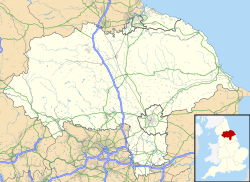| RAF Topcliffe | |||||||||
|---|---|---|---|---|---|---|---|---|---|
| Topcliffe, North Yorkshire in England | |||||||||
 A Grob Viking T.1, similar to the type flown by No. 645 Volunteer Gliding Squadron based at Topcliffe | |||||||||
| Site information | |||||||||
| Type | Military airfield | ||||||||
| Code | TP | ||||||||
| Owner | Ministry of Defence | ||||||||
| Operator | Royal Air Force | ||||||||
| Controlled by | No. 22 Group (Training) | ||||||||
| Condition | Operational | ||||||||
| Location | |||||||||
| Coordinates | 54°12′20″N001°22′56″W / 54.20556°N 1.38222°W | ||||||||
| Area | 117 hectares | ||||||||
| Site history | |||||||||
| Built | 1939–1940 | ||||||||
| In use | 1939 – present | ||||||||
| Battles/wars | Second World War Cold War | ||||||||
| Airfield information | |||||||||
| Identifiers | ICAO: EGXZ, WMO: 03265 | ||||||||
| Elevation | 28 metres (92 ft) AMSL | ||||||||
| |||||||||
| Source: UK Military Aeronautical Information Publication – Topcliffe (EGXZ) [1] | |||||||||
Royal Air Force Topcliffe or RAF Topcliffe( ICAO : EGXZ) is a Royal Air Force station in North Yorkshire, England.
Contents
- History
- Second World War
- Cold War
- 21st century
- Role and operations
- Based units
- Royal Air Force
- Civilian
- See also
- References
- Citations
- Bibliography
- External links
It was established as a RAF Bomber Command station in 1940. The British Army took over a large part of the site in 1974 and the airfield became an enclave within Alanbrooke Barracks. The last remaining RAF unit is No. 645 Volunteer Gliding Squadron which operates the Grob Viking T.1 glider.


